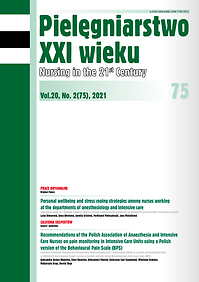The occurrence of ovarian cancer in the population of urban and rural women, BRCA1 and BRCA2 genes mutation testing and the general rules on the patient's consent to treatment
DOI:
https://doi.org/10.2478/pielxxiw-2021-0016Keywords:
ovarian cancer, BRCA gene mutations, prophylaxisAbstract
THE OCCURRENCE OF OVARIAN CANCER IN THE POPULATION OF URBAN AND RURAL WOMEN, BRCA1 AND BRCA2 GENES MUTATION TESTING AND THE GENERAL RULES ON THE PATIENT'S CONSENT TO TREATMENT
Introduction. The BRCA1 and BRCA2 genes belong to suppressor genes that control the mechanisms of repairing various damages of the DNA double helix, regulate cell division, and the cell cycle. Mutations within these genes are associated with the hereditary ovarian and breast cancers.
Aim. Assessment of the frequency of testing BRCA1 and BRCA2 gene mutation in the population of women living in urban and rural environments with diagnosed ovarian cancer.
Material and methods. The study was conducted among 300 women seeking treatment or consulting a doctor from the Wielkopolska Oncology Center in Poznań, and patients treated in a home hospice in the Rawicz district in Wielkopolska province over the period 2016-2018.
Results. Among the respondents, the most were women aged from 36 to 40 (53.3%). The age of developing ovarian cancer for the women from cities is between 41 and 45. In the vast majority of women, i.e. 247 (82.3%), epithelial cancer was diagnosed. A marker that could indicate ovarian cancer, i.e. CA 125 antigen, was determined in more than half of 165 (55.0%). However, only in a few cases, in a total of 25 (8.3%) patients a test confirming the presence of BRCA1 and BRCA2 gene mutation was performed.
Conclusions. The possibility of testing for BRCA1 and BRCA2 gene mutation in all sick women and their closest family should be considered. Regardless of the age of women, it is important to raise awareness of the risk of ovarian cancer, encourage them to keep regular medical appointments, and perform diagnostic tests.
References
1. Didkowska J, Wojciechowska U, Czaderny K. Nowotwory złośliwe w Polsce w 2017 roku. Krajowy Rejestr Nowotworów. Warszawa: Centrum Onkologii – Instytut im. Marii Skłodowskiej-Curie, 2019.
2. Plagens-Rotman K, Chmaj-Wierzchowska K, Pięta B, Bojar I. Modifiable lifestyle factors and ovarian cancer incidence in women. Ann. Agric. Environ. Med. 2018; 1: 36-40.
3. Kurman RJ, Shih IM. The Origin and Pathogenesis of Epithelial Ovarian Cancer: A Proposed Unifying Theory. Am. J. Surg. Pathol. 2010; 34: 433-443.
4. Budiana ING, Angelina M, Pemayun TGA. Varian cancer: Pathogenesis and current recommendations for prophylactic surgery. J. Turk. Ger. Gynecol. Assoc. 2019; 26: 47-54.
5. Mavaddat N, Peock S, Frost D. Cancer risks for BRCA1 and BRCA2 mutation carriers: results from prospective analysis of embrace. J. Natl. Cancer. Inst. 2013; 5: 812-822.
6. Dowdy SC, Stefanek M, Hartmann LC. Surgical risk reduction: prophylactic salpingo-oophorectomy and prophylactic mastectomy. Am. J. Obstet. Gynecol. 2004; 191: 1113-1123.
7. Koh SC, Huak CY, Lutan D, et al. Combined panel of serum human tissue kallikreins and CA-125 for the detection of epithelial ovarian cancer. J. Gynecol. Oncol. 2012; 23: 175-181.
8. Kossai M, Leary A, Scoazec J-Y, Genestie C. Ovarian Cancer; A heterogeneous disease. Pathobiology. 2018; 85(1-2): 41-49.
9. Xinxin Z, Jinghe L. Programmed death-1Pathway Blockade Produces a Synergistic Antitumor Effect Combined Application In Ovarian Cancer. J. Gynecol. Oncol. 2017; 5: 64.
10. Eisenhauer EA. Real-world evidence. In the treatment of ovaria cancer. Ann. Oncol. 2011; 1(8): 28.
11. Vargas AN. Natural history of ovarian cancer. J. Cancer. Sci. Ther. 2014; 6: 247-252.
12. Lalrinpuii E, Bhageerathy PS, Sebastian A. Ovarian Cancer in Young Women. Peedicayil. A Indian. J. Surg. Oncol. 2017; 4: 540-547.
13. Pujade-Lauraine E, Ledermann JA, Selle F, et al. Olaparib tablets as maintenance therapy in patients with platinum-sensitive, relapsed ovarian cancer and a BRCA1/2 mutation (SOLO2/ENGOT-Ov21): a double-blind, randomised, placebo-controlled, phase 3 trial. Lancet Oncol. 2017; 9: 1274-1284.
14. Kruczała MA, Grela-Wojewoda A, Cedrych I. PARP inhibitors in the ovarian cancer therapy. Ginekol. Pol. 2016; 87: 131-134.
15. Górski B, Byrski T, Huzarski T, et.al. Founder mutations in the BRCA1 gene in Polish families with breast-ovarian cancer. Am. J. Hum. Genet. 2000; 6: 1963-1968.
16. Riedlova P, Janoutova J, Hermanova B. Frequency of mutations in BRCA genes and other candidate genes in high-risk probands or probands with breast or ovarian cancer in the Czech Republic. Mol. Biol. Rep. 2020; 4: 2763-2769.
17. Plagens-Rotman K, Chuchracki M, Piskorz-Szymendera M, et al. Reproductive factors and the endometrial cancer morbidity. Eur. J. Gynaecol. Oncol. 2019; 3: 431-436.
18. Plagens-Rotman K, Piskorz-Szymendera M, Chmaj-Wierzchowska K, Pięta B. Breast cancer - Analysis of the selected risk factors. Eur. J. Gynaecol. Oncol. 2017; 3: 425-430.
19. Plagens-Rotman K, Żak E, Pięta B. Odds ratio analysis in women with endometrial cancer. Prz. Menopauz. 2016; 1: 12-19.
20. Act of November 6, 2008 on patient rights and the Ombudsman for Patient Rights (consolidated text of the Journal of Laws of 2020, item 849).
21. The Code of Medical Ethics. Available online: https://nil.org.pl/uploaded_images/1574857770_kodeks-etyki-lekarskiej.pdf, access: 11.06.2020.
Downloads
Published
Issue
Section
License
Copyright (c) 2021 Authors

This work is licensed under a Creative Commons Attribution-NonCommercial-NoDerivatives 4.0 International License.




